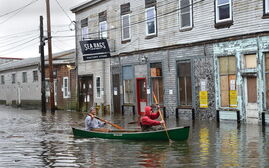Innovation, R&D and jobs will drive Maine’s future
 Photo / Tim Greenway
Hannah Pingree, who served four terms in the state Legislature, is director of Gov. Janet Mills’ Office of Policy Innovation and the Future.
Photo / Tim Greenway
Hannah Pingree, who served four terms in the state Legislature, is director of Gov. Janet Mills’ Office of Policy Innovation and the Future.
Hannah Pingree is director of Gov. Janet Mills’ Office of Policy Innovation and the Future. She served four terms in the Maine House of Representatives, and was Speaker of the House from 2008-10. She helped spearhead legislation on energy, broadband, housing, environmental health and health care. She is also a daughter of U.S. Rep. Chellie Pingree, D-Maine 1st District. Mainebiz caught up with her to talk about some of the issues facing Maine’s economy, including broadband, clean energy initiatives and possible growth areas.
Mainebiz: What are some areas where Maine could grow its economy?
Hannah Pingree: There is tremendous potential in our heritage industries, like forestry, fishing and farming. They are ripe for growth through investment and innovation. We see exciting opportunity in new, value-added farm and seafood products to increase demand in these industries and, importantly, reduce the distance that our food must travel to feed our residents and region. Gov. Janet Mills has set a goal to double the number of clean energy jobs to 30,000 by 2030.
MB: With the surge of new residents, can Maine’s rural broadband initiatives keep pace with the demand?
HP: The urgency for reliable, affordable and accessible high-speed broadband in Maine was made even more apparent during the last year. State and federal leaders have taken bold action to address gaps and poor service across the state. The new Maine Connectivity Authority, just signed into law by Gov. Mills will use up to $150 million in federal funds to support broadband infrastructure investments and leverage both local and private funds.
MB: We’ve seen former paper mills in Millinocket (data center), Bucksport (aquaculture) and Madison (wood-fiber insulation) become sites for forward-looking industries. How can Maine prepare workers for new job opportunities?
HP: These exciting new industries in Millinocket, Bucksport and Madison show how Maine is competitive in the global marketplace, and that our rural economies can thrive with new investment and support new career opportunities for workers and their families.
Unfortunately, [lack of] workforce still hampers our state’s future economic growth. Maine has been dealing with a gap of available workers for years, which is why it is critical to prepare our young people, and workers looking for a transition, with the skills needed to thrive in growing careers of the future. The state’s new Maine Jobs & Recovery Plan utilizes new federal funding opportunities to make transformational investments in our workforce systems — from our high school career and technical education programs to our universities and community colleges.
Maine must attract new workers — a focus on being a welcoming state, open to diversity, is key to that — because our current workforce is not able to support robust growth.
MB: Where does support for startups, innovative ventures, and entrepreneurs fit into Maine’s economic picture?
HP: We have a strong foundation. Institutions like the University of Maine have driven innovation in areas like clean energy, forest products and more. Maine’s life sciences sector is incredibly vibrant, led by organizations such as the Jackson Laboratory. And remarkable new organizations, like the Roux Institute in Portland, are poised to take the level of support for innovation and entrepreneurs to the next level.
Yet Maine lags the nation in spending on R&D, a point highlighted by the Maine’s Jobs & Recovery Plan, the state’s Economic Recovery Committee and the 10-year Economic Plan. We need to galvanize support for our entrepreneurs and drive innovation. We’ve launched a Clean Energy Innovation Challenge to provide two companies with up to $250,000 each to advance new technology or products that address climate and clean energy goals.
MB: How is the administration addressing housing and childcare issues?
HP: The pandemic especially clearly showed the connection between foundational community infrastructure — like housing, childcare and transportation — to our economic health and vibrancy. As a parent who has spent a lot of time trying to work while at home with kids, I’ve been reminded first-hand of the value of quality education and care opportunities for our children. At the same time, our state’s red-hot housing market has made housing less affordable and available for working families, which must be addressed. The Maine Jobs & Recovery Plan calls for significant investment in childcare infrastructure and affordable housing in response to the pandemic, based on the experience Maine had during the pandemic.
This is not enough, though, and I’m glad to see that the state’s Department of Health and Human Services start to move aggressively to enhance childcare in a way not seen since World War II.
Mainebiz web partners
I found Pingree's response to the question "What are some areas where Maine could grow its economy?" disappointing and lacking in ambition and insight into the present and future capabilities of the entire working population of Maine. We can own and strive towards a more diverse economy future we want for Maine that is not solely dictated by our heritage.














1 Comments